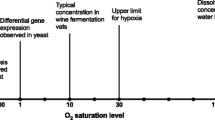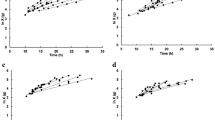Summary
The net benefit that Saccharomyces cerevisiae obtains from aerobiosis as compared to anaerobiosis has been studied. For this purpose yeasts with different respiratory capacities have been obtained by growing them in batch cultures on different substrates. Even with sugars with low catabolite repression effect, as is the case of galactose, aerobiosis increased the growth rate and the growth yield by less than two-fold. These variations, which are much lower than the expected considering the actual oxygen utilization, indicate that either the amount of ATP produced in respiration is much lower than the theoretically expected or a much greater expenditure of ATP occurs in aerobic than in anaerobic growth. The results show that S. cerevisiae obtains only a slight benefit from aerobiosis when growing on sugars at the relatively high concentration prevailing in its natural habitats.
The inhibition of sugar consumption rate by aerobiosis (Pasteur effect) has also been studied, Pasteur effect was almost unnoticeable during growth on any tested sugar and very low during ammonia starvation. These results contrast with the general belief that Pasteur effect is a quantitatively important phenomenon in yeast. It is concluded that the relevant observations of Louis Pasteur have little relationship with the phenomenon that bears his name.
Similar content being viewed by others
References
Payne, W., 1970. In Ann. Rev. Microbiol. 24, 17–51.
Stouthamer, A. H. and Bettenhaussen, C. W., 1973. Biochim. Biophys. Acta. 301, 53–70.
Polakis, E. S., Bartley, W., and Meek, G. A., 1965. Biochem. J. 97, 298–302.
Lagunas, R., 1976. Biochim. Biophys. Acta. 440, 661–674.
Jayaraman, J., Cotman, C., Mahler, H. R., Sharp, C. V., 1966. Arch. Biochem. Biophys. 116, 224–251.
Umbreit, W. W., Burris, R. H. and Stauffer, J. F., 1957. Manometric Techniques, 3rd. ed. Burgess Publishing Co, Minneapolis.
Bergmeyer, H. U., 1974. Methods of Enzymic Analysis, 2nd ed., Academic Press, New York.
Roe, J. H., 1955. J. Biol. Chem. 212, 335–343.
Lagunas, R. and Gancedo, J. M., 1973. Eur. J. Biochem. 37, 90–94.
Gancedo, J. M. and Lagunas, R., 1973. Plant Sci. Letters, 1, 193–200.
Walkil, S. J. and Barnes, E. M., 1971. In Comprehensive Biochemistry (Florkin, M., Stotz, E. H., eds.) vol 18S, pp. 57–104. American Elsevier Publishing Co. New York.
Grylls, F. M. S., 1961. In Biochemist's Handbook (Long C., ed.) pp. 1050–1053. E. & F. N. Spon, London.
Sanedi, D. R. and Jacobs, E. E., 1967. In Methods in Enzymology (Estabrook, R. W., Pullman, M. E. eds.), vol X, pp. 48–67. Academic Press, New York.
Mackler, B. and Haynes, D., 1973. Biochim. Biophys. Acta. 292, 88–91.
Ohnishi, T., 1973. Biochem. Biophys. Res. Commun. 41. 344–352.
von Meyenburg, K., 1969. In Continuous cultivation of microorganism (Malék, L, Beran, K., Sencl, Z., Munk, V., Ricica, J., Smrčková, H., eds.) pp. 129–146. Academic Press, London.
Neijssel, O. M. and Tempest, D. W., 1976. Arch. Microbiol. 110, 305–311.
Rogers, P. S. and Stewart, P. R., 1974. Arch. Microbiol, 99, 25–47.
Lynen, F., Hartmann, G., Netter, K. F. and Schuegraf, A., 1959. In Ciba Foundation Symposium on the Regulation of Cell Metabolism. (Wolstenholme, C. E. W., O'Connor, C. M., eds.), pp. 256–273, J. A. Churchill Ltd, London.
Holzer, H., 1961. In Cold Spring Harbor Symposium on Quant. Biol. 26, 277–288.
Fiechter, A., Schatzmann, H., Rathjen, F. G. and Ono, T., 1977. In Euchem Conference on Metabolic Reactions in the Yeast Cell in Anaerobic and Aerobic Conditions, pp. 17–20. Helsinki.
Krebs, H. A., 1972. In Assays in Biochemistry (Campbell, P. N., Dickens, F., eds.), Vol 8, pp. 1–35, Academic Press, New York.
Ramaiah, A., 1974. In Current Topics Cell. Reg. (Horecker, B. L., Stadtman, E. H., eds), Vol 8, pp. 297–245. Academic Press, New York.
Racker, E., 1974. Mol. Cell. Biochem. 5, 17–23.
Sols, A., 1976. In Reflections in Biochemistry (Kornberg, A. Horecker, B. L., Cornudella, L. and Oró, J., eds.), pp., 199–206. Pergamon Press, London.
Tejwani, G. A., 1978. TIBS 3, 30–33.
Pasteur, L. 1861. Comp. Rend. Acad. Sci. 52, 1260–1264.
Hunter, K. and Rose, A. H., 1970. In The Yeast, (Rose, A. H., Harrison, J. S., eds.), Vol 2, pp. 211–270. Academic Press. New York.
Author information
Authors and Affiliations
Rights and permissions
About this article
Cite this article
Lagunas, R. Energetic irrelevance of aerobiosis for S. cerevisiae growing on sugars. Mol Cell Biochem 27, 139–146 (1979). https://doi.org/10.1007/BF00215362
Received:
Issue Date:
DOI: https://doi.org/10.1007/BF00215362




